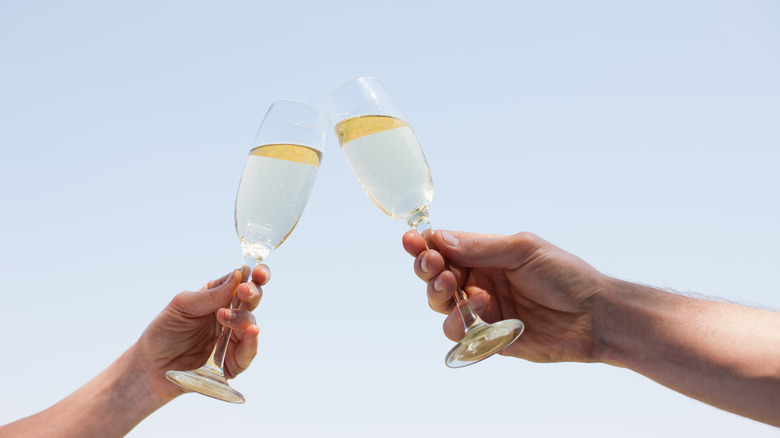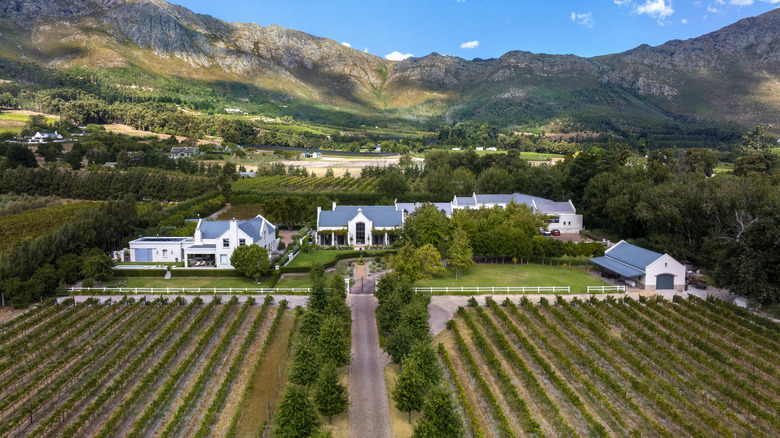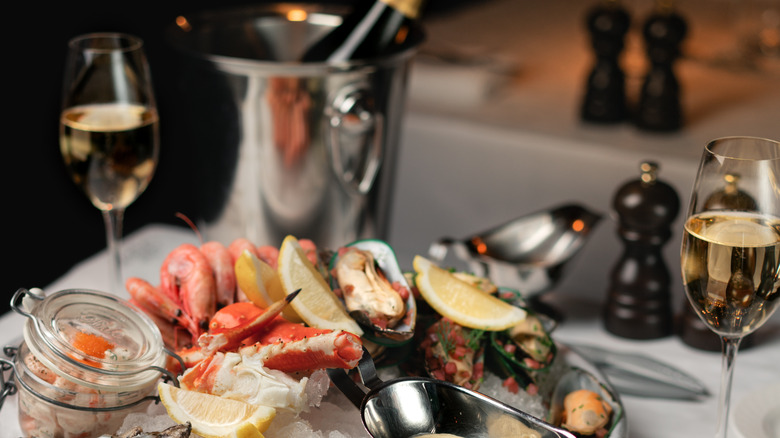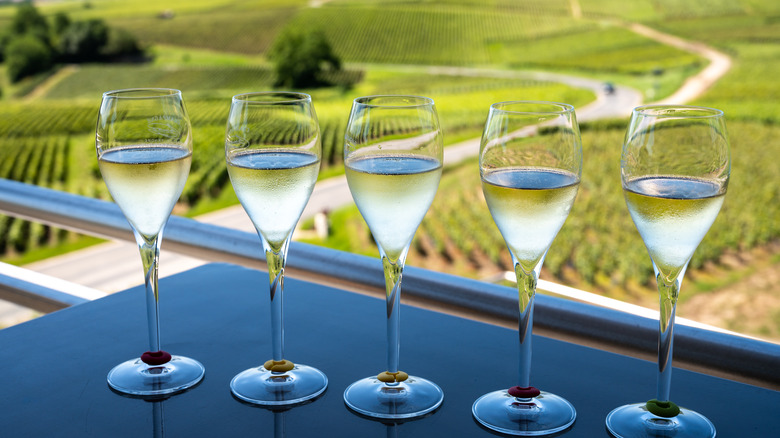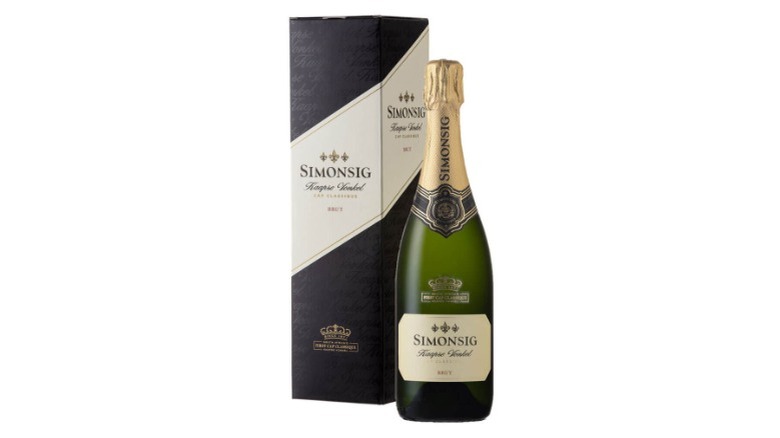What Is Cap Classique, South Africa's Sparkling Wine?
While Champagne is the big kid on the block when it comes to sparkling wine, having an excuse to drink bubbly without spending a small fortune is something everyone deserves, no matter where in the world you are. This explains the prosecco boom during the last decade, as well as growing interest in sparkling wines like Spanish cava and French crémant. Lesser known is Cap Classique — a sparkling wine made in South Africa that is made in the same way as Champagne but using locally grown grapes.
The name Cap Classique (also known as Méthode Cap Classique or MCC) is a reference to South Africa's Cape Winelands, where the wine is produced. Though South Africa has a long history of wine production, Cap Classique is a relatively new product – barely fifty years old. The wine has a steadily growing export market — up 10% from last year, according to the Cap Classique Producers Association (CCPA) — and is worth trying, especially for Champagne fans looking for a good deal.
How is Cap Classique made?
According to Caroline van Schalkwyk, head of marketing for the CCPA, Cap Classique is made from traditional grape varietals like Pinot Noir and Chardonnay (and to a lesser extent, Pinot Meunier), as well as the less traditional but still popular Chenin Blanc. It is produced using the Méthode Traditionnelle, also known as the Méthode Champenoise or the Méthode Cap Classique, which requires a second fermentation in the wine bottle after the initial fermentation.
Aside from the Méthode Cap Classique, there are not many regulations on Cap Classique. Any kind of grape may be used (though the ones mentioned are strongly encouraged by the CCPA), and it can be produced anywhere in South Africa. Cap Classique must be aged on the lees (the winemaking term for the dead yeast residue left in a bottle) for at least 12 months (compared to 15 for Champagne), but prestige cuvées are generally aged for at least three years.
The South African sparkling wine must also be bottled under a pressure of at least 3 bar (compared to 6 bar for Champagne). Generally, the more pressure, the more bubbly the wine. Additionally, there are different categories of Cap Classique depending on the level of sweetness, including Brut (dry), Brut Naturale (very dry), and Nectar (somewhat sweet).
What does Cap Classique taste like?
"Cap Classique comes in a variety of styles so there is something to suit every taste," van Schalkwyk said. "From bone dry to demi-sec, there are Cap Classiques made in all styles. Demi-Sec is a fast growing style in South Africa and Africa."
The longer a bottle of Cap Classique is aged on the lees, which help flavor the wine, the more of a buttery, brioche-like quality it will have, bringing it closer in flavor to Champagne. Meanwhile, Cap Classique that is aged for a shorter period will have a fresher and fruitier flavor, with notes of citrus and stone fruit. But the taste will ultimately depend on where in South Africa the grapes are grown, as different soil types and micro-climates can create dramatic differences in flavor.
Cap Classique is bubbly and effervescent, and as such, best served cold. Smoked salmon and seafood dishes pair well with Cap Classique, as do pork, chicken, egg, and cheese dishes with a side of asparagus or other steamed vegetables.
Cap Classique vs. Champagne, prosecco, and cava
Because Cap Classique is made using the Méthode Traditionnelle, it will bear some similarities to other sparkling wines made in the same way, like Champagne, crémant, Franciacorta, and cava. Prosecco, on the other hand, uses the Charmat method, which involves doing the second fermentation in a large, pressurized tank instead of a bottle. This approach is easier and takes less time, resulting in bigger bubbles and fruiter flavors.
Cap Classique has a comparable ABV to these other sparkling wines (around 10 or 11%), and is similarly high in acidity, with occasional notes of bread or baked goods. However, it tends to be fruiter than Champagne. It typically uses the same French grapes as Champagne, while cava uses Spanish grapes, and prosecco uses Italian Glera grapes. Though South Africa has a Mediterranean climate, which would normally produce sweeter wines with higher ABVs, its cool evenings and sea breezes make the region surprisingly well-suited to producing balanced wines.
Cap Classique is aged for longer than prosecco and cava, but not as long as Champagne, putting it in a Goldilocks-kind of middle ground among the sparkling wines.
Popular brands and prices of Cap Classique
Cap Classique came about in the year 1971, when Frans Malan of Simonsig Estate decided to establish a Champagne-style South African sparkling wine after a visit to the region in France. Today, more than 250 vineyards in South Africa specialize in Cap Classique — most of them in the region of Stellenbosch. A few leading producers are Graham Beck, Boschendal, L'Ormarins, Villiera, and Haute Cabrière.
Only 17% of Cap Classique wines are exported, according to the CCPA, with the United Kingdom and the Netherlands holding ground as the top two international markets, followed by the U.S. But if you can find a bottle stateside, it'll be a bargain, with most major brands selling their cuvées for under $20.
Van Schalkwyk said that in South Africa, Cap Classique ranges from about R120 ($7) to over R1000 ($55), with the majority selling at retail for around R200 ($11) per bottle, and prestige cuvées selling for upwards of R700 ($38) per bottle.
